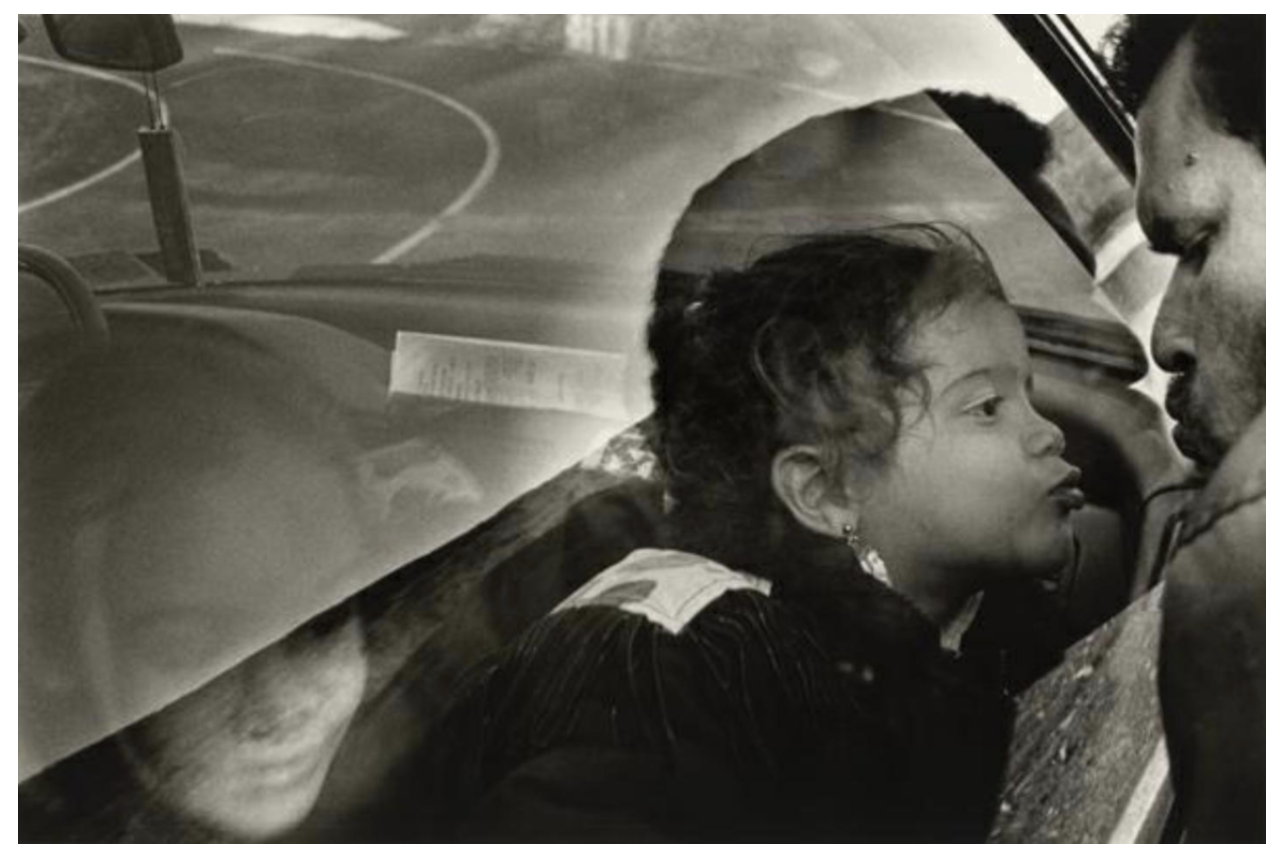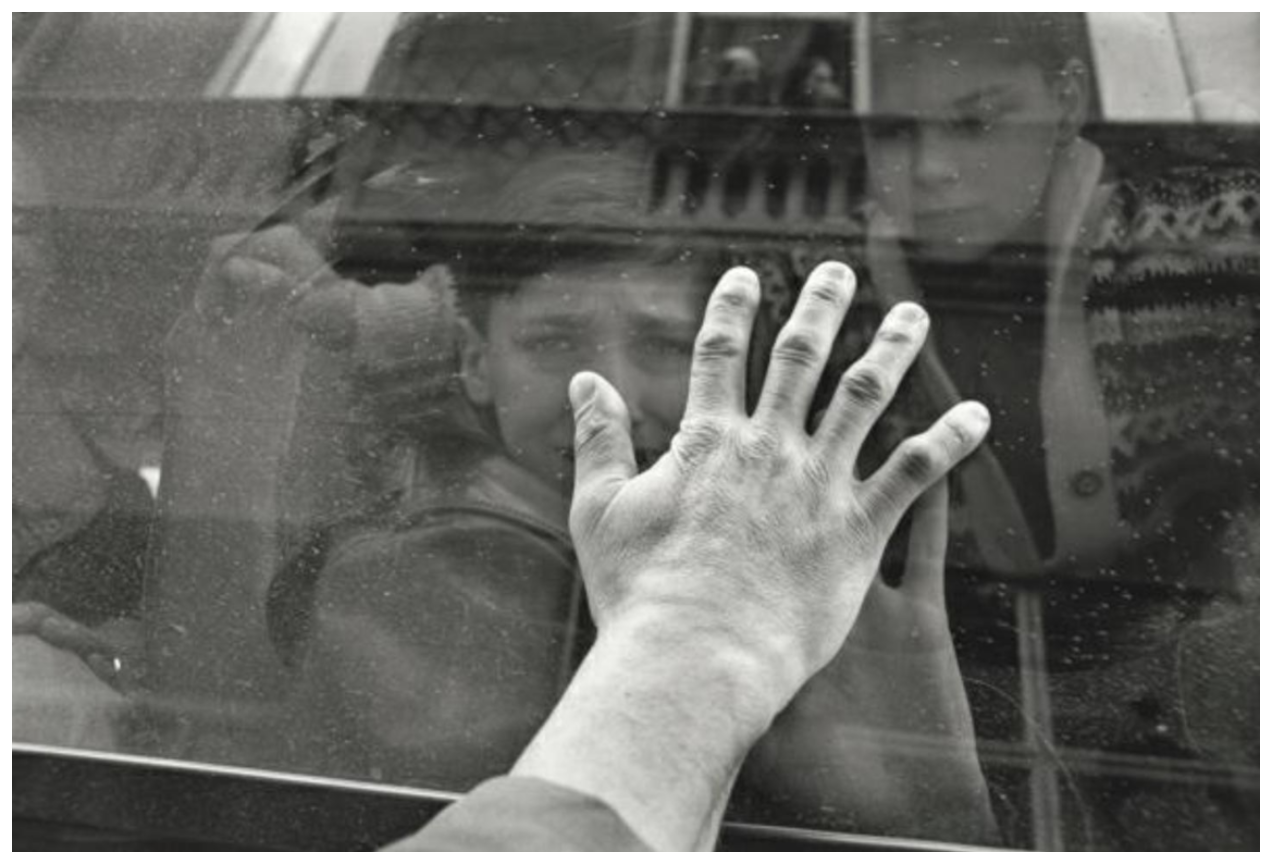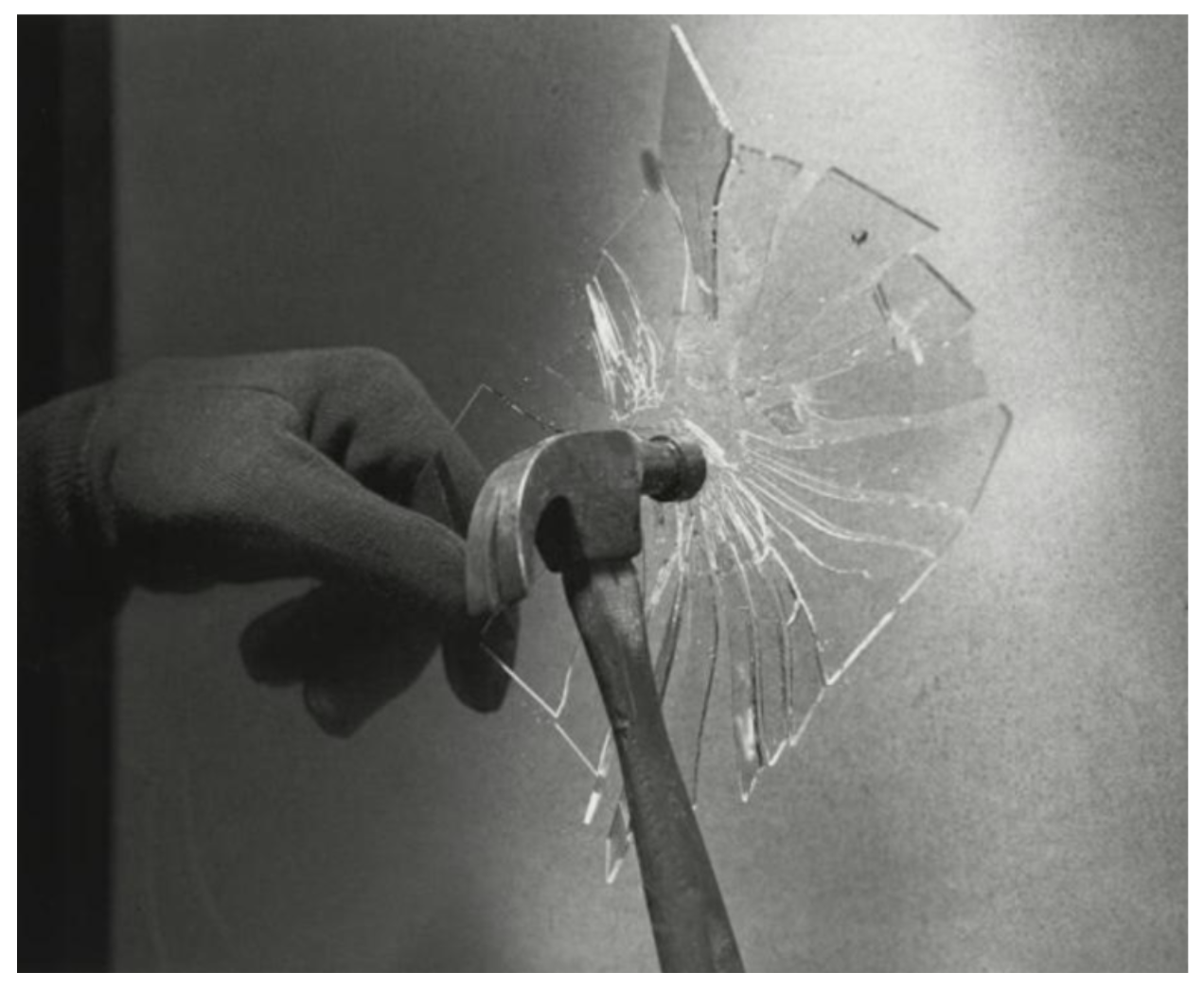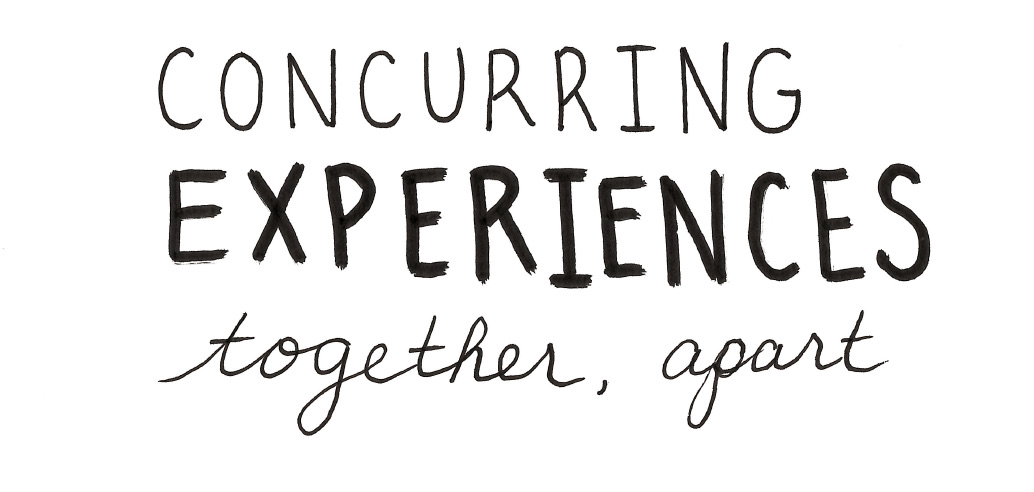Connect Change
Steve Hart
Gelatin silver print
38.10 H x 50.48 W cm (15 H x 19 7/8 W in)
Gift from the Trustees of the Corcoran Gallery of Art (Gift of the artist)
© Steve Hart
Text by Saskia Giramma
After the Funeral, 1992 from "Married, Not Dead"
Image Description:
After the Funeral depicts Ralph kissing his youngest daughter through a car window after her mother, Sensa, died of AIDS related complications. This collection portrays the tragic story of an American family living in poverty and struggling with drug addiction, physical abuse, and HIV through intimate photographs of their lives.
Artist Bio:
In 1989 Steve Hart, an award-winning documentary photographer, was asked to photograph a support group in New York for people living with HIV and AIDS. He developed a relationship with a Puerto Rican couple named Ralph and Sensa, both living with AIDS from intravenous drug use. After the Funeral is part of a collection, called A Bronx Family Album: The Impact of AIDS, of photographs of this couple and their family over a seven-year period.
Edward Serotta
Gelatin silver print
40.64 H x 55.88 W cm (16 H x 22 W in)
Gift from the Trustees of the Corcoran Gallery of Art (Gift of the Central Europe Center for Research and Documentation)
© Edward Serotta
Text by Saskia Giramma
Harris Karalic, a Muslim, bids goodbye to his son Denis, who is being taken out of war ravaged Sarajevo by the Jewish community on a rescue convoy, 1994
Image Description:
A hand presses against a glass window separating Harris Karalic from his son Denis, “who is being taken out of war ravaged Sarajevo by the Jewish community on a rescue convoy”, as the title describes. We see the reflection of a balcony over top of a boy’s eyes looking at the camera sadly. Another boy stands behind him.
Harris Karalic, a Muslim, bids goodbye to his son Denis, who is being taken out of war-ravaged Sarajevo by the Jewish community on a rescue convoy was originally published in Serotta’s book Survival in Sarajevo: Jews, Bosnia, and the Lessons of the Past in 1994, and was exhibited in 2016 in an exhibition of the same name. The book tells the story of La Benevolencija, a Jewish community center and humanitarian aid organization which came into being during the Bosnian war in 1992 as an organization where anyone could ask for help regardless or ethnic or religious background.
Artist Bio:
Edward Serotta is a journalist and photographer who specializes in Jewish life in Central and Eastern Europe. Between 1993 and 1995 Serotta spent a total of 45 days in war-torn Yugoslavia taking photographs. The boy in the photograph, Denis Karalic, was 15 years old when this photo was taken. He was sent out of the country to Israel with a friend’s family to live away from the violence of the war. He now lives in Vienna, works at the Jewish Museum, and has become a surrogate son to Serotta.
Harold Eugene Edgerton
Gelatin silver print
50.64 H x 40.96 W cm (19 15/16 H x 16 1/8 W in)
Gift from the Trustees of the Corcoran Gallery of Art (Gift of Mr. Pete Kayafas)
© Estate of Harold E. Edgerton
Text by Nora Neely
Hammer Breaking Glass Plate, 1933
Image Description:
A stillness rests in the air of this photograph, the damage outlined, the glass prepared for descent. A hammer protrudes from the middle of the frame, standing as strong as a street sign or a flag pole, and fluttering beside it is a gloved, human hand, which seems involved in the incident. There is a crystalized beauty within the destruction, and a sort of natural pattern to the smashing glass. The moment, stuck in time, is silent. The hammer caught red-handed.
Today, our modern eyes may be much more accustomed to see what was, in 1933, a groundbreaking discovery, redefining the limits of photography. Now that screens are embedded into our social fabric, have we reached the limit of what photography can achieve? What more can photography do? Are photographs inherently meant to capture a moment? Do photographs relay a false message of stillness to what is constantly in motion?
Artist Bio:
Even as a young artist in 1933, Harold Eugene “Doc” Edgerton worked to unlock new visual understandings of the world. He had inventive and scientific tendencies, deeply examining the speed of motion, following the chase to capture it on-screen. Hammer Breaking Glass Plate is one of the lesser-known (but equally emotive and powerful) photographs in Edgerton’s expansive body of work (ie. Milk Drop Coronet, 1957). Overall, his art challenged the mechanics of photography and cinematography infinitely, as he continually pushed the boundaries of high-definition and documentary capabilities. Edgerton discovered innovative lighting processes, such as high-tech strobe lights with camera shutter motors, which captured stop-motion pictures, moments moving too fast for our eyes to see. Gus Kayafas, a student and colleague, worked alongside Edgerton throughout his scientific art process, collaborating in a partnership which would produce several iconic exhibitions among many galleries.
Coming out of this moment strongly, together, we realize that we need to collectively agree to not return to ‘the norm’. We need to break the glass, to shatter our old standards, systems and divisions, to bring light to our community, to help each other. Unemployed Workers United has a mission to do just that, committing to “[creating] an economy and society that respects all working people, their families and their communities.”
Please visit www.uwunited.org
To stay updated about DC mutual aids, sign up for the 730DC newsletter here: 730DC
Also check out this amazing document, organized by 730DC
including some ways to donate, volunteer, mutual aid around the city: Links for Helpers
"We have published our newsletter since 2013. Every morning we send out news from around the city, along with things to do. It's a tool for connecting people to the city, its communities, and to one another. In a society where so many forces drive us apart that is already going against the grain.
This pandemic has further radicalized us, and how we’ll approach publishing this newsletter, in two ways that are actually one. First, cut off as we are now, we are more convinced than ever that to be human is to live together. Second, we are also persuaded that we must do better as a city to prevent, not react, to suffering; to address, not just redress, inequality; to prioritize people, not profit; that we need a change not only in degree but kind of relation with one another. We will try to make this newsletter should be a tool for conviviality, for living together, and not just in peace but active solidarity with one another." -Hayden Higgins, 730DC
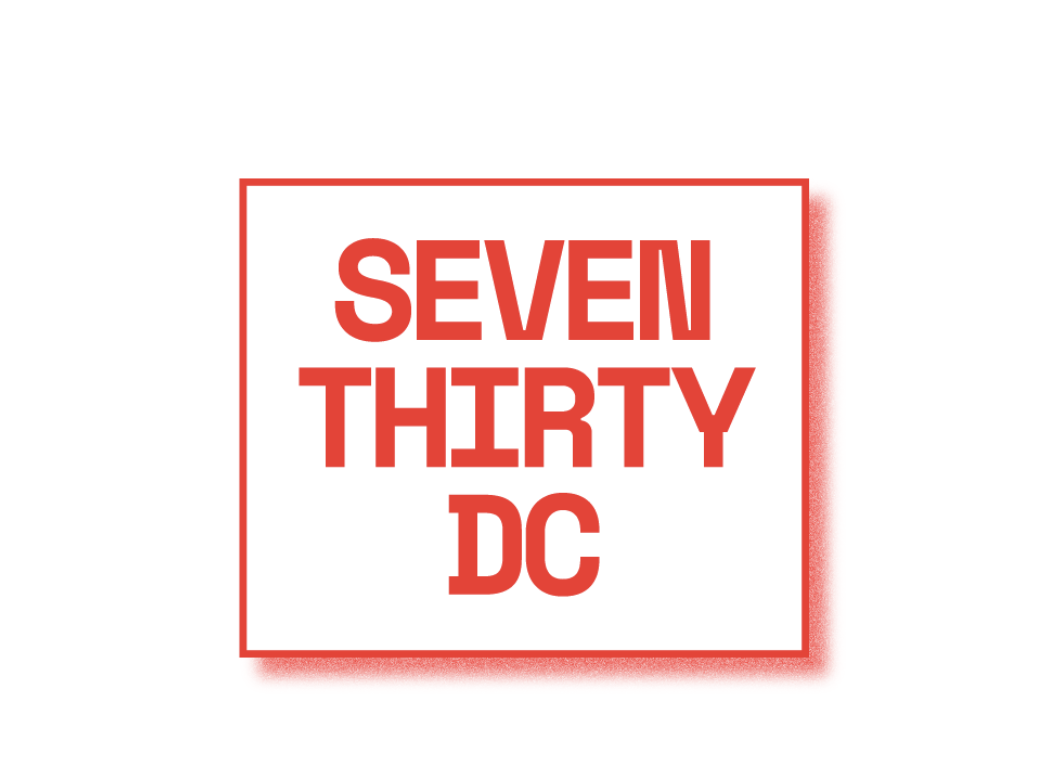
Click to Continue to the Next Group of Photographs:
Or Return to Full Gallery:


